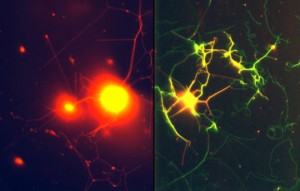Artificial Nerve-like Structures Made with a Biological System


Fluorescent microscopy images of polymer nanotubes (left) and polymer nanotubes + protein microtubules (right). Each “node” of the networks is about 20 microns in diameter, and some of the tubes are longer than 100 microns. Credit: Image courtesy of Sandia National Laboratories
Scientists from Sandia National Laboratories have used natural proteines to create nerve-like structures out of artificial polymers. The biologically linked nanotubes could convey electrical impulses. The breakthrough study, published in the journal Nanoscale, opens the doors to the use of these novel structures as a painless interface between nerve ends and prosthetic limbs.
Electrodes are electrical conductors used to make contact with a nonmetallic part of a circuit. Currently, people who replace a lost limb with an artificial one must deal with electrodes that are inserted in their nerve ends and connect them with the limb. Electrodes must penetrate nerve tissue, are rigid structures and cause inflammation. The artificial nerves are, by contrast, soft structures, and could serve as a more tolerable interface.
A biological factory made of kinesins
Kinesins are motor proteins found in eukaryotic cells. Kinesins move along microtubule filaments, and are powered by the hydrolysis of adenosine triphosphate (ATP). Their movement supports several cellular functions, notably the transport of cellular cargo. The researchers used arrays of kinesins as nanomotors for the assembly of polymers. First, they attached the kinesins “shoulders” to a glass surface, leaving their “legs” upwards, freely moving. Next, they positioned streptavidine-coated microtubules on the kinesins. The fixed kinesins moved the microtubules in a structure resembling a conveyor belt. Finally, the scientists placed polymer (poly(ethylene oxide-b-butadiene) spheres next to the microtubules. The streptavidine allowed microtubules to acquire sticky properties and thus adhere to the polymer. With the collective force generated by the kinesins, the microtubules in movement were able to extract nanotubes from the polymer vesicles.
This system generated networks ranging from hundreds of micrometers to tens of millimeters, composed of tubes 30 to 50 nanometers in diameter. Future goals are obtaining highly branched structres and carrying information and electricity through them.
Source: ScienceDaily


